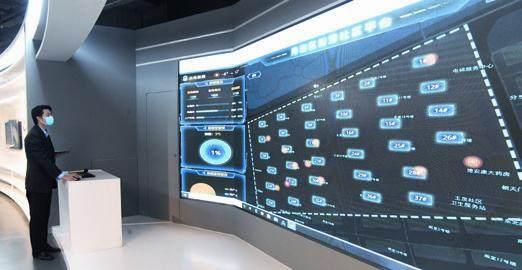LIVING THE HI-TECH LIFE
2022-06-09ByLuYan
By Lu Yan
Nearby a nucleic acid testing site in Beijings Haidian District, you will spot a roadside sign featuring a QR code. Scanning it with their smartphones, people can see how many testing sites are in the vicinity, their respective locations and operating hours, the number of people waiting in line at each site at that exact moment, and the estimated waiting time.
The QR code is one of the functions of the areas official account on WeChat, one of Chinas most popular super apps. It was developed by the Institute of Automation under the Chinese Academy of Sciences, an organization focusing on intelligent science and technology innovation that is located in the area.
Beijing has conducted multiple rounds of mass nucleic acid testing, based on its districts individual conditions, as the Chinese capital races against the clock to contain its latest COVID-19 resurgence that began in late April.
Fortunately, a range of prevention and control measures, such as mass testing, targeted lockdowns and working from home, have brought positive case numbers down gradually in this city with a permanent population of nearly 22 million, with the cooperation and understanding of its residents.

“I feel grateful for the timely and targeted actions taken by the local government. Especially with smart technology, residents can choose a site where there are fewer people, thus saving time and avoiding large gatherings,” Wang Ying, an office clerk working in Haidian, told Beijing Review.
Intelligent technologies and methods have been combined with existing service resources in the neighborhood, to give residents convenient access to information on government affairs, business, entertainment, education and medical care.
Under the current complex pandemic circumstances, smart technologies have taken up an important role in community services, such as residential information statistics, transportation management, health monitoring, pandemic trend analysis and telemedicine.
Convenience for all
In May, a document on the further expansion of intelligent communities across China was issued by nine government departments, including the Ministry of Civil Affairs(MCA), the National Development and Reform Commission, and the Ministry of Industry and Information Technology. According to the MCA, the document encourages the application of information technology, such as the Internet of Things (IoT), big data, cloud computing and artificial intelligence(AI), to forge a smart service circle in neighborhoods that benefits the people and improves public services.DEE5B070-A181-4DDB-973C-F19EEBAE8E89
While in the West, the term“community” has multiple definitions, like a group of people united by a common interest or people actively striving toward a common goal; in China, a community usually refers to a residential neighborhood.
The scale of a community usually comprises over 1,000 households, or 3,000 people. A community often has a clinic, a police station or office, and an entertainment center.
“Digital technology is profoundly changing peoples lifestyles, making social management more efficient,” said Liu Qingfeng, Chairman of leading Chinese AI firm iFlytek and a national lawmaker. He said that the building of a smart community can especially improve the lives of its senior residents.
Fengtai Community in Jincheng, Shanxi, has undergone a major overhaul since October 2019. Originally established in the 1980s, the community used to have many problems such as outdated facilities and poor sanitation. After the renovations, conducted under a government campaign giving old residential areas a full makeover, Fengtai has upgraded both its hardware and software.
For example, Liu Xianglian, an 82-year-old resident living by herself, installed a smart water meter at home. Based on IoT technology, the system regularly and automatically reports the water consumption of senior citizens to the community management platform. If an abnormality occurs, staff will check in on the resident to make sure all is well.
“Im usually home alone. First, the community workers came over to change the water meter. I didnt get it. I didnt expect it to have so many functions. But when I use too much, or too little, water, community workers will come to my apartment to see if Im ok. That warms my heart,” Liu told Chinanews.com.
Smart technology also bolsters peoples green endeavors. Dayufeng Community in Hengshui, Hebei Province, set up intelligent garbage classification bins. By, for example, clicking the “paper” option on the bins touchscreen and entering a mobile phone number, residents can put their packaged carton into the bin, receive money for it and put that straight into their WeChat Wallet, a smartphone payment service.
These bins are also used for recycling fabrics, metal, plastic and glass bottles, thus helping people dispose of their household waste in an eco-friendly manner.
“The key to building a smart community lies in big data capabilities,” said Pu Yafei, a community worker at the Weitang Community in Shenzhen, Guangdong Province. This community mainly houses young people. Via several online platforms, the communitys self-governing committee has gathered residents with similar hobbies to form clubs and hosted hundreds of related activities.DEE5B070-A181-4DDB-973C-F19EEBAE8E89
Risky business?
“Smart communities can optimize resource allocation, improve community services, and lift residential quality of life, but at present, there are still some shortcomings that need to be fixed,” said Zhang Fulei, an associate professor at the School of National Governance under Southwest University, adding that some service applications and facilities are flashy and seem smart but are not easy to use.
The use of new technology also comes with its fair share of controversy. One example here is the facial recognition systems at residential building entrances: While admittedly ensuring security, many residents are concerned their images and personal information are not secure.
“The application of facial recognition technology in daily life is getting more and more common. As for where it can and cannot be used, thats a line legislation must define,” Cai Yongbo with China Legal Exchange Foundation said at a seminar in February.
“This technology is still in its early stages. The solution to many a hi-tech hiccup, and risk, may only appear through the development of technology itself,” Yuan Peijiang, an associate professor with the School of Mechanical Engineering and Automation at Beihang University, shared at the same event.
“The construction of smart communities still has a long way to go. Relevant parties should accurately identify the needs of different residential groups, like seniors and children, to improve targeted services,” Zhang concluded. BRDEE5B070-A181-4DDB-973C-F19EEBAE8E89
